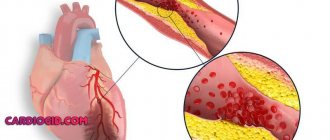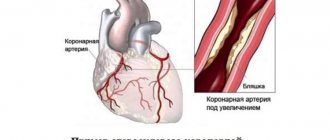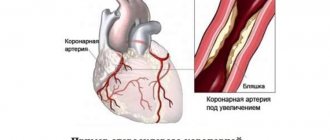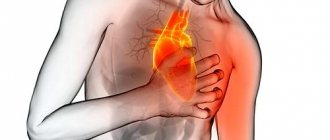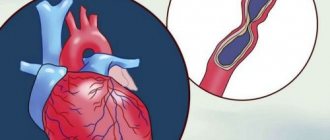Reasons for the development of the disease
The main cause of angina is ischemia, which develops against the background of many years of deposition of atherosclerotic plaques on the inner walls of the arteries. Gradually increasing, this layer reduces the lumen of the artery, against the background of this, the blood pressure on the walls increases, the vessels themselves lose their elasticity and become more rigid. Through narrowed arteries, blood flow pathologically decreases, and as a result, the myocardium does not receive the vitamins and oxygen it brings in the amount necessary for normal functioning.
Various risk factors are involved in the development of angina; it is important to note that they are the same for all diseases of the cardiovascular spectrum:
- Diabetes mellitus and other endocrinological disorders.
- Excess body weight.
- Hereditary predisposition.
- High blood pressure
- High cholesterol and low-density lipoprotein levels
- Low high-density lipoprotein levels
- Predominantly sedentary lifestyle with insufficient physical activity.
- Smoking, alcohol, other bad habits.
- Occupational factors, for example, constant excessive physical activity.
- Chronic lack of sleep.
Much less often, angina occurs against the background of infectious and infectious-allergic lesions. Emotional stress also provokes angina attacks.
Make an appointment with a specialist, without queues, at a convenient time
+7
Sign up
Rehabilitation after discharge
After diagnosis, you need to introduce some changes to your lifestyle:
- Review your diet to prevent potassium and magnesium deficiency, eat fish at least 2 times a week, increase the number of fruits and vegetables, especially those containing beta-carotene and vitamin C, it is important not to overeat;
- To refuse from bad habits;
- Try to avoid physical activity;
- If they cannot be avoided, take nitroglycerin before physical effort;
- Constantly monitor blood pressure;
- If you have gastrointestinal diseases and diabetes, monitor the progress of the diseases.
Symptoms of angina
Acute pain occurs in the area of the upper or lower third of the sternum, much less often in the epigastric region, under the left shoulder blade or in the left shoulder. The pain can radiate to both arms or only to the left, to the neck and even to the jaw area. The nature of pain in patients with angina varies, but it is predominantly a sensation of squeezing or severe burning. Sometimes the pain becomes unbearable and is accompanied by the development of a person’s fear of death and inexplicable anxiety. The duration of ischemic pain in most cases is 5-10 minutes, less often – up to 15 minutes.
The patient also has:
- Increased sweating.
- Violation of heart rhythm in any direction - tachycardia or bradycardia.
- Unstable myocardial dysfunction, such as systolic blood pressure.
Degree of disease development
Angina can be stable or unstable. The first category is divided into:
1st degree
– difficult to diagnose, manifests itself only during prolonged physical exertion.
2nd degree
– climbing stairs is very difficult; in the slightest stressful situation, tachycardia and a pressing sensation in the chest occur. In a state of physical or emotional peace, the discomfort goes away.
3rd degree
– even minor stress causes an attack; it can also be triggered by changes in the weather.
4th degree
– an extremely dangerous stage of angina pectoris for humans. Elementary loads and any excitement are contraindicated. Attacks can occur even when a person is resting and not at all nervous.
Unstable angina is divided into:
- Occurring for the first time
is a serious reason to suspect cardiac ischemia in the patient. - Progressive
– the condition gradually worsens, attacks become more frequent and intensified. - Post-infarction
– angina develops for the first time after a heart attack or surgery. - Spontaneous (angina at rest)
- occurs unexpectedly without obvious reasons.
I 20.0 – Unstable angina – example of writing a call card
Patient, 64 years old
Reason for calling – Chest pain (history of coronary artery disease)
Complaints, medical history
Complaints of general weakness, pressing pain behind the sternum, burning sensation radiating to the left shoulder, back (between the shoulder blades), sweating, feeling of lack of air.
The feeling worsened for about 6 hours, the pain arose at rest, intensified with the slightest physical activity, short-term relief after taking isoket spray. I took isoket spray about 10 doses, bisoprolol 10 mg, lisinopril 10 mg, cardiomagnyl 1 tablet. This is not the first time this condition has happened; he was previously treated as an inpatient. During physical activity, she notes infrequent short-term attacks of chest pain, which are relieved with rest after taking nitrates, after 5-10 minutes.
Anamnesis of life
Hypertension stage III. IBS. PEAKS (2012). Diabetes mellitus type II. Cerebrovascular disease.
Regularly takes enalapril 10 mg/day, bisoprolol 10 mg/day, cardiomagnyl 1 tablet/day, maninil 1 tablet/day.
Comfortable blood pressure – 140/90
Physical examination
Condition: moderate;
Consciousness – clear, Glasgow scale – 15 points, behavior – calm;
Pupils – normal, D = S, reaction to light – lively, no gaze paresis, no nystagmus;
Skin – pale, dry, clean;
Heart sounds are muffled, rhythmic, no murmurs. The pulse in the peripheral arteries is of satisfactory quality, rhythmic;
Nervous system – without pathology, no meningeal symptoms;
The pharynx is calm, the tonsils are normal;
Excursion of the chest - normal, type of breathing - normal, percussion - pulmonary sound, auscultation - vesicular breathing, no shortness of breath;
There is no peripheral edema;
The tongue is clean and moist. The abdomen is soft, painless, participates in the act of breathing, there are no symptoms of peritoneal irritation, the liver is not enlarged, stool is formed, 1 time per day;
Urine output is normal, SSPO is negative.
Main pathology
Consciousness is preserved, the patient is adequate. The skin is pale and dry. Heart sounds are muffled and rhythmic. The pulse in the peripheral arteries is of satisfactory quality, rhythmic.
| time | 15-30 | 15-50 | 16-10 | 16-30 | Etc. peace |
| NPV | 18 | 16 | 16 | 16 | 16 |
| Pulse | 86 | 64 | 66 | 64 | 62 |
| Heart rate | 86 | 64 | 66 | 64 | 62 |
| HELL | 160/100 | 150/90 | 140/90 | 140/90 | 140/90 |
| Pace. ºС | 36,6 | ||||
| SpO2 | 95 | 98 | 98 | 98 | 98 |
Blood glucose – 6.5 mmol/l
Troponin test – negative
Electrocardiography
15-35 – Sinus rhythm 86 per minute. Signs of left ventricular hypertrophy. Signs of subepicardial damage to the anterior wall (ST depression I, II, aVL, V1-V4 1-2 mm). Negative dynamics with previous ECGs.
15-50 – Sinus rhythm 64 per minute. No dynamics from the previous ECG.
16-30 – Sinus rhythm 64 per minute. No dynamics from the previous ECG.
Diagnosis by the EMS team
IBS. Unstable angina III B (Braunwald). Post-infarction cardiosclerosis.
Therapeutic measures
- oxygen inhalation through nasal catheters
- 15-36 – peripheral vein catheterization
- 15-37 – Isoket spray s/l 1 dose every 5 minutes – 4 doses (no effect)
- 15-38 – Tav. Acidi acetylsalicylici 250 mg p/os
- 15-38 – Tav. Plavix 300 mg p/os
- 15-39 – Sol. Clexani 4000 ED IV
- 15-42 – Sol. Betaloc 10 mg IV
- 15-45 – Sol. Morphini hydrochloride 1% – 1 ml intravenously in fractions
- ECG monitoring
- hospitalization on a stretcher to the regional vascular center.
Treatment result
Improvement. The pain syndrome was relieved by the administration of morphine and did not recur during transportation.
Which doctor should I contact?
Any alarming signs characterizing pathological processes in the heart are a reason to immediately go to an appointment with a cardiologist. Self-medication, the use of traditional methods or advice from doctors that other patients have received is unacceptable. Each clinical case of angina is unique - it is provoked by various factors and has varying degrees of severity, therefore, without individual diagnosis and a treatment program developed specifically for you, it will not be possible to overcome the disease.
Make an appointment with a specialist, without queues, at a convenient time
+7
Sign up
Diagnosis of angina pectoris
- Electrocardiogram.
- Sequential analysis of cardiac biomarkers (eg, CPK, troponin, myoglobin, etc.)
- Complete blood count with determination of hemoglobin level
- Serum biochemical analysis (including magnesium and potassium)
- Physical testing of a patient in stable condition
- Chest X-ray
- ECHO ECG
- Computed tomography angiography
- Magnetic resonance angiography
- Single photon emission computed tomography
- Magnetic resonance imaging
- Myocardial perfusion imaging
- Holter monitoring
When carrying out differential diagnosis in a patient, it is necessary to exclude aortic stenosis and hypertrophic cardiomyopathy, which are accompanied by hemodynamic angina. Instrumental research methods have significant diagnostic value.
Treatment of angina
Treatment for angina depends on the severity of the condition. Most often, treatment tactics are selected with the aim of:
- Reducing myocardial oxygen demand
- Improves blood supply to the myocardium
- Assess the risk of myocardial disease progression or treatment-related complications.
In severe cases, a surgical method is also used - coronary artery bypass surgery.
Make an appointment with a specialist, without queues, at a convenient time
+7
Sign up
Treatment
For several weeks after the first attack makes itself felt, the patient's condition requires close monitoring and intensive treatment until stabilization. After the examination, certain methods of treating angina pectoris are prescribed. In order to prevent complications and relieve pain, the patient may be prescribed drug therapy and physiotherapy. If the disease actively progresses, a decision is made to perform surgical intervention: intravascular coronary stenting or open coronary artery bypass surgery.
Make an appointment with a cardiologist
The best cardiologists at the private Multidisciplinary Medical Center are experienced specialists who will help you get rid of serious heart and vascular diseases. If, after diagnosis, angina is detected, we prescribe patients adequate and effective treatment, talk about prognosis and further prevention. Under the supervision of professionals, it will be easier to defeat the disease, which means you can count on a long life without heart pain.
You can make an appointment for a fee with a cardiologist at an affordable price at a convenient time by calling Clinic No. 1 or using the feedback form on the medical institution’s website.
Moscow, st. Krasnodarskaya, house. 52, bldg. 2
+7
We work on weekdays and weekends from 8.00 to 21.00
Definition
New-onset angina is a type of angina in which symptoms of an attack appear in the patient for the first time in life (or after a long absence).
Being one of the characteristic symptoms of coronary heart disease, angina pectoris signals that the heart muscle is insufficiently supplied with blood. New-onset angina belongs to the most dangerous form - unstable angina. The danger in this case is that the consequences of such a “debut” can be unpredictable.
Prices for consultation and appointment with a cardiologist
| Name | Price |
| Blood pressure measurement | 60,00 |
| Consultation after MRI/MSCT | 540,00 |
| Initial consultation with a pulmonologist | 1800,00 |
| Initial appointment with a cardiologist (consultation) | 1800,00 |
| Initial appointment with a rheumatologist | 1800,00 |
| Repeated consultation with a pulmonologist | 960,00 |
| Repeated appointment with a cardiologist | 960,00 |
| Repeated appointment with a rheumatologist | 960,00 |
| Preoperative examination by a cardiologist (doctor’s appointment, ECG, interpretation) | 2460,00 |
| ECG interpretation | 600,00 |
| Taking an ECG | 360,00 |
| 24-hour blood pressure monitoring | 2400,00 |
| 24-hour Holter ECG monitoring | 3000,00 |
| ECG with stress | 1950,00 |
